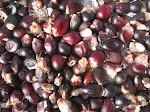Another Rainy Harvest Day
by Aozora Brockman
The story on the farm this year so far is rain, rain, rain, especially--it seems to me--rain on harvest days.
This Tuesday and last Tuesday, we picked for the CSA in the rain and through thunderstorms and Daddy says they are calling for rain and severe weather all day tomorrow again.
Last Friday thunderstorms and dark rain clouds dumped water onto the soil that had just finally dried out enough to plant. Of course, Daddy knew this was going to happen, so as soon as the soil was dry enough on Thursday, we proceeded to plant every seed and transplant every plant possible before the rains came. The planting marathon spilled over into Friday, which meant having to plant and harvest for the farmers market at the same time, which was a relatively new experience for me.
While Kazami harvested wild arugula, Grandpa regular arugula, and the interns (Matt, Rebecca, and Daniel) plus Mommy sorrel, Asa, Daddy and I planted lettuce with the tractor.
The skies started to rumble as we were finishing up and the rain started to pitter-patter down while Daddy expertly maneuvered the truck up the steep hill leading to the wash area. It wasn't until we were safely under the barn's high roof that the droplets crescendoed into an angry downpour. While we eagerly ate the scrumptious food Mommy cooked for us, I listened to the thundering water hit the barn roof and watched as it washed off the side and hit the soil below. I couldn't sit mesmerized for long, though, because the twenty boxes of beautiful emerald spinach and a few boxes of mesclun that we had picked at daybreak were waiting to be bagged and boxed.
The rain let up a little as that huge job was conquered, but the sky above was still overcome with black rain clouds, letting little light pass through. Despite this, Daddy declared that it was time for us to make another round to the bottom field, while it wasn't raining so hard.
I got on the truck with the rest, and marveled at how our huge, multicolored raingear-orange, red, green, yellow-- topped with our two-sizes-too-big boots made us look like a clown act at the circus. Perhaps we could get the job, since the extra weight from the mud on our boots caused us to hobble around hilariously. The truck sliplessly made its way down the hill, past the alfalfa and clover field, and rounded the corner to reveal the ford across the stream that divides our two bottom fields. It came to an abrupt stop, which sent Asa on his feet to exclaim, "The ford! Look at the ford!"
The ford, which just this spring had finally been completed by adding medium sized white rocks to the slabs already there, had overflowed. Grandpa told us later that we got three inches of rain that morning (and still more to come). The stream, usually small and obedient, had suddenly risen after the cloudburst, its rushing waters three times as large and 10 times as vicious.
With one look, I decided it impossible to cross. Daddy and everyone else seemed to think so too, except Asa. "Let's cross it, just for fun!" he said with a grin. Much to his disappointment, Daddy drove us back up to the barn. While he did this, lightning flashed and the clouds opened up again, filling the air with the sound of their fury.
But Daddy rounded us all up and we went off to the greenhouse to harvest the beets and carrots, while the rain pounded down so hard on the plastic roof we had to shout at each other to be heard over it. By the time we finished, the thunder and lightning had calmed down a bit and the infamous truck, loaded with its troupe of multi-colored clowns and taking the long way around to skirt the ford, rumbled its way onto the main road off our driveway, past the upper field and partway down the small hill leading to the rhubarb patch.
Horrified, we stared at our beloved bottom field. At first we all thought Walnut Creek had overflowed its banks, since there was so much water everywhere. But then we saw that the little trench Daddy dug to channel water from a ravine into our stream had backed up with debris and overflowed. With nowhere else to run, the water was flowing in a huge sheet straight across the bottom field. Mini streams were building up and causing even more water to flood.
Daddy woke us all up from our stupor and set us to work. Kazami and Daniel scrambled off to find suitable shovels and then we were ordered to dig into the trench to make it wider and deeper. Rebecca and Daniel took off to gather wood to block the water where it was jumping the gully and heading into the field. Meanwhile, Asa cleared the gully of debris all the way to the stream.
I was in the middle, trying to convince my shovel to dig into the trench and dump the dirt onto the sides. The task was more difficult than you would think, since tenacious roots of grass growing in the bottom of the gully kept getting in the way, and sometimes I would lose my dug dirt in the water. Even more frustrating was that my shovel's handle kept coming off. Originally I had scored a better shovel, but Asa switched his with mine. Of course, I had known there was something wrong with it, like maybe the shovel was dull, but never that the handle would actually come off. During a particularly hard dig, I tried to pull my shovel up. I failed miserably, as the handle popped off and I was flung into the trench water. Daddy laughed and helped me up. I giggled a bit as I got up, but then I realized my boots had just filled up with water and glared at Asa. I stuck my shovel back together again.
In the end, we got the flow of water directed straight into the stream again and the trench was a success. The water on the field was eventually soaked up by the soil and the roots of the plants, but Daddy says a lot of the broccoli and cabbage aren't going to make it because they have been in standing water too long. Soaked to the skin, sweaty and dirty, boots laden with mud, we trudged off to the field to pick the rhubarb and the radishes and finish a long, long, wet, wet harvest day!




 everything shimmer and glow.
everything shimmer and glow. o water, and made us gallons and gallons of delicious apple and pear cider.
o water, and made us gallons and gallons of delicious apple and pear cider.



















